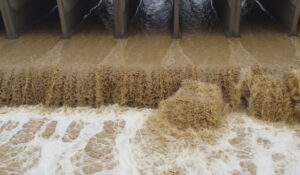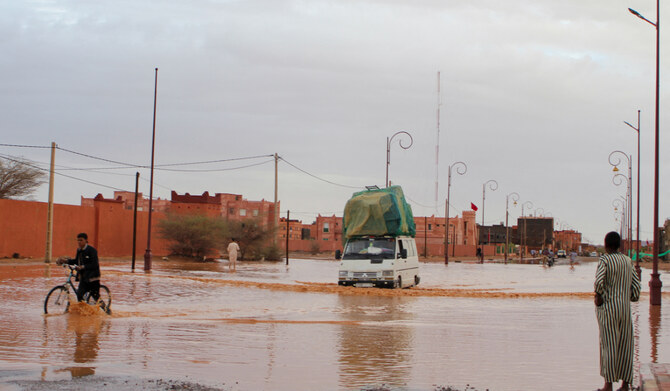Morocco and Algeria floods: Heavy rains in North Africa’s arid regions have caused devastating claiming more than 20 lives. This rare deluge brought destruction to areas that usually receive very little rainfall, damaging homes, infrastructure, and leaving many people missing.
Unprecedented Flooding Hits Morocco
Torrential rains have wreaked havoc in southern Morocco, causing widespread flooding and the loss of 18 lives. The two-day downpour, which started on September 7, 2024, far surpassed the region’s typical annual rainfall. Rural areas, already struggling with poor infrastructure, were the hardest hit, with 56 homes collapsing due to the Morocco and Algeria floods.
Many regions impacted by this recent flood were the same areas that faced a devastating earthquake a year ago. The flooding not only disrupted communities but also severely damaged critical infrastructure, including roads, drinking water systems, and electrical grids.
Morocco’s Interior Ministry spokesperson, Rachid El Khalfi, urged citizens to exercise caution and avoid flooded areas while rescue operations continue. Efforts to restore communication and access to cut-off regions are already underway, although the extent of the damage is still being assessed.
Among the dead are foreign nationals from Canada and Peru, who were likely visiting the region for its famous desert landscapes, further highlighting the widespread impact of the Morocco and Algeria floods.
Floods Destroy Homes and Infrastructure
The Morocco and Algeria floods have been particularly damaging in rural areas, where infrastructure has historically been insufficient. With entire communities cut off due to flooded roads and damaged bridges, reaching the affected areas has been difficult for emergency responders.
Many of the homes that were destroyed were built using traditional materials that could not withstand such extreme weather conditions. Residents in these regions typically experience less than an inch of rain annually, making the sudden deluge particularly catastrophic.
The heavy rains have also caused widespread damage to the country’s electrical grids and drinking water systems. Authorities are working to repair these services as quickly as possible, but the task is daunting given the scope of the destruction.
Algeria Faces Similar Tragedy
Morocco wasn’t the only country hit by the rare North African downpour. In neighboring Algeria, at least five people were killed when floods ravaged the desert provinces. The torrential rains arrived during a tense presidential election weekend, further complicating the country’s ability to respond swiftly to the Morocco and Algeria floods.
Interior Minister Brahim Merad called the flooding “catastrophic” and reported that thousands of civil protection officers and military personnel have been deployed to assist in emergency operations. Their efforts have focused on rescuing families trapped in their homes by rising waters and repairing the infrastructure that has been critically damaged, including bridges and train services.
Algeria’s state-run news service, APS, confirmed the extent of the devastation, noting that the government’s priority is to rescue and provide aid to those affected by the Morocco and Algeria floods.
With both Morocco and Algeria grappling with the destruction left in the wake of these floods, the combined death toll has exceeded 20 people. The situation remains dire as rescue teams work around the clock to save those still stranded in flood-stricken areas.
Meteorologists Had Warned of the Rare Sahara Deluge
While the intensity of the flooding has caught many by surprise, meteorologists had predicted that an unusually strong storm system would hit the region. North Africa’s Sahara Desert, which typically experiences less than an inch of rain per year, was at the center of the storm’s path.
The Morocco and Algeria floods have hit some of the most vulnerable areas in the region, places that are ill-equipped to handle heavy rainfall. The infrastructure in these desert regions was not designed to withstand such extreme weather conditions, leaving many communities completely unprepared for the storm’s impact.
With both countries still recovering from previous disasters, the floods have been a devastating blow, especially to regions already dealing with the aftermath of the 2023 earthquake in Morocco.
Destruction of Tourism Hotspots
In addition to impacting local communities, the Morocco and Algeria floods have caused extensive damage to Morocco’s desert tourist regions. Many tourists visit the southern regions of Morocco, like Tagounite and Zagora, to experience the Sahara’s breathtaking landscapes. However, these same regions have now been overwhelmed by floodwaters, trapping visitors and locals alike.
The Morocco and Algeria floods killed more than 20 people, and the tourism industry may take a significant hit as the country grapples with the disaster’s aftermath. The presence of foreign tourists among the dead highlights the far-reaching consequences of the disaster, as families from around the world are affected by this tragedy.
Ongoing Rescue and Recovery Efforts
Both Morocco and Algeria have mobilized significant resources to address the disaster. In Morocco, rescue teams are working tirelessly to reach isolated communities cut off by floodwaters. The government is also focusing on repairing critical infrastructure, such as roads and bridges, to allow aid to flow into the most affected areas.
In Algeria, the government has sent military officers and civil protection workers to desert provinces where the floods have destroyed roads and stranded families. Authorities are using helicopters to airlift those in immediate danger while attempting to restore essential services.

The Morocco and Algeria floods continue to pose significant challenges for both countries. The priority for now is to rescue those who remain missing and provide much-needed aid to the affected populations. With infrastructure severely damaged, this process is expected to take time.
The Long Road to Recovery
The Morocco and Algeria floods have underscored the vulnerability of North Africa’s desert regions to extreme weather events. With infrastructure that was never designed to handle such conditions, the governments of Morocco and Algeria face a long road to recovery.
For the people affected by the Morocco and Algeria floods, rebuilding their homes and lives will be an immense challenge. In addition to the physical destruction, the emotional toll of losing loved ones, homes, and livelihoods is immeasurable.
The international community may need to step in to provide support as both Morocco and Algeria continue their recovery efforts. As the Morocco and Algeria floods killed more than 20 people, these countries will require significant resources to rebuild and ensure that future disasters do not have such devastating consequences.
In conclusion, the Morocco and Algeria floods highlight the need for stronger infrastructure and preparedness in these vulnerable regions. The impact of this disaster will be felt for years to come, as communities work to rebuild from the devastation.
Keep following this page for updates as the situation continues to unfold.








